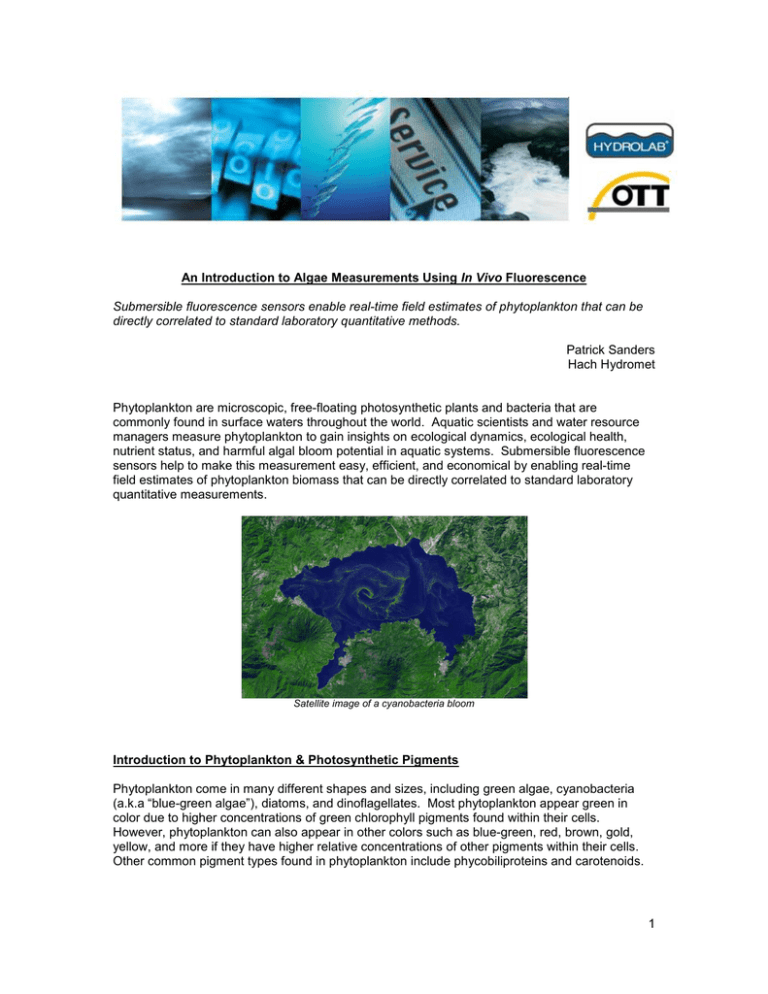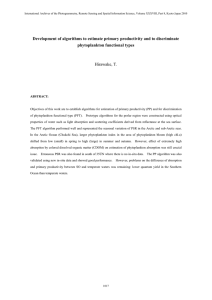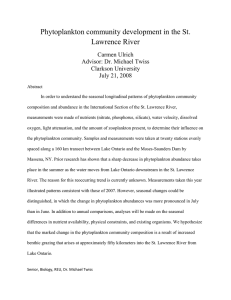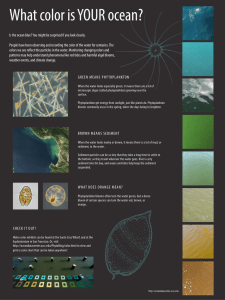Download, 380.13 KB
advertisement

An Introduction to Algae Measurements Using In Vivo Fluorescence Submersible fluorescence sensors enable real-time field estimates of phytoplankton that can be directly correlated to standard laboratory quantitative methods. Patrick Sanders Hach Hydromet Phytoplankton are microscopic, free-floating photosynthetic plants and bacteria that are commonly found in surface waters throughout the world. Aquatic scientists and water resource managers measure phytoplankton to gain insights on ecological dynamics, ecological health, nutrient status, and harmful algal bloom potential in aquatic systems. Submersible fluorescence sensors help to make this measurement easy, efficient, and economical by enabling real-time field estimates of phytoplankton biomass that can be directly correlated to standard laboratory quantitative measurements. Satellite image of a cyanobacteria bloom Introduction to Phytoplankton & Photosynthetic Pigments Phytoplankton come in many different shapes and sizes, including green algae, cyanobacteria (a.k.a “blue-green algae”), diatoms, and dinoflagellates. Most phytoplankton appear green in color due to higher concentrations of green chlorophyll pigments found within their cells. However, phytoplankton can also appear in other colors such as blue-green, red, brown, gold, yellow, and more if they have higher relative concentrations of other pigments within their cells. Other common pigment types found in phytoplankton include phycobiliproteins and carotenoids. 1 Phytoplankton come in many different shapes, sizes, and colors Pigments provide a vital function by absorbing light energy needed for photosynthesis. In this process, light energy from the sun drives a reaction where carbon dioxide and water are converted into sugars. Oxygen is given off as a reaction byproduct. As phytoplankton are able to create their own chemical energy through this process, they are commonly referred to as “primary producers” within aquatic ecosystems. These primary producers form the foundation of aquatic food webs, where they are consumed by organisms higher up on the food chain, such as zooplankton, invertebrates, and fish. Photosynthesis reaction that occurs within phytoplankton and all photosynthetic organisms The photosynthesis reaction in phytoplankton is powered by light energy absorbed by various accessory pigments and channeled to an energy collecting pigment where a reaction center is located. This energy collecting pigment is typically chlorophyll a, which is present in all phytoplankton. Concentration measurements of chlorophyll a are frequently used as a standard means of estimating phytoplankton biomass and productivity. In cyanobacteria, the accessory pigments phycocyanin and phycoerythrin are commonly measured to assess cyanobacteria biomass. Importance of Phytoplankton Measurement Measuring phytoplankton can provide valuable insights regarding the biological status of any given aquatic system. Some common applications include: Primary Productivity Quantification As phytoplankton form the foundation of aquatic food webs, concentrations of phytoplankton can have a direct effect on all organisms higher up on the food chain. Quantifying primary production through phytoplankton biomass measurements is a common way to gather direct insights on the baseline energy available within any given aquatic food web. Eutrophication / Nutrient Status Monitoring Eutrophication is the process where nutrients such as nitrogen and phosphorous are loaded into an aquatic system, typically caused by watershed run-off inputs. Eutrophic systems are highly prone to phytoplankton blooms which can lead to dissolved oxygen depletion when phytoplankton cells die off. Phytoplankton monitoring can help water resource managers to control watershed inputs that can affect nutrient loading within aquatic systems. 2 Harmful Algal Bloom (HAB) Monitoring Certain species of phytoplankton, mainly cyanobacteria, can release toxins that can cause adverse health effects to humans and animals. Continuous monitoring of phytoplankton levels as part of a broad management plan can help water quality managers to decrease the prevalence of health incidents due to harmful algae. Drinking Water Management Certain species of phytoplankton can produce compounds that create taste and odor issues in water, including the compounds 2-MIB and geosmin. Proactive phytoplankton monitoring can provide data that helps managers determine when and where to apply algaecide, as well as which source water intakes to pull from in order to minimize the biological load entering a treatment system. An Introduction to Fluorescence Measurement Fluorescence can be described as the phenomena of certain molecules or compounds that absorb specific wavelengths of light and instantaneously emit energy wavelengths of light. Relevant to the topic of phytoplankton measurement, chlorophyll, phycocyanin, and phycoerythrin are all fluorescent pigments that can be measured using fluorescence instrumentation. Fluorescence measurements of these pigments can be made in vitro (“within the glass”) in the laboratory and in the field with submersible in vivo (“within the living”) fluorescence sensors. Real-time in vivo phytoplankton measurement using fluorescence sensors on a Hydrolab sonde Within phytoplankton, absorbed light energy in the photosynthetic pigments is channeled to the photosynthesis reaction center, and is either dissipated as heat or re-emitted as fluorescence. On a molecular level, the underlying mechanism of fluorescence is the same for organic or inorganic fluorescent molecules because they both involve the movement of electrons. Specific photons of light energy cause electrons within fluorescent molecules to move to a higher orbital from their original ground state. This electron orbital change lasts a short period, and when the excited electrons return to their ground state, a photon of light at a lower energy wavelength relative to the initial photon is released. This emitted lower energy photon is known as the fluorescence emission. Fluorescence sensors measure the fluorescence intensity of an analyte, which is typically directly proportional to its concentration within a linear range. When measurements are made beyond the linear range, light from the sensor is not able to completely pass into the measurement area due to the density of the analyte (for example, an in vivo chlorophyll a sensor deployed directly within a green algae bloom). This condition is called “quenching” and it can cause sensors to read lower than the actual concentration within the measurement area. If spot sampling, one can 3 address quenching by taking grab samples and diluting them by a known factor in order to take measurements within the linear range of the sensor. Illustration of how the in vivo chlorophyll a fluorescence sensor works on Hydrolab sondes In Vitro Laboratory Measurement Methods There are multiple methods of measuring phytoplankton in a laboratory environment. Although these in vitro laboratory methods can be relatively time intensive, carefully collected data from these methods provide highly valuable quantitative data in meaningful mass-to-volume units. The most common laboratory methods used include manual cell counting as well as photosynthetic pigment concentration analysis using various laboratory procedures and instrumentation. Counting cells in a known volume of water is one laboratory method of quantifying phytoplankton biomass. This method can either be done visually with a microscope or with instrumentation such as a flow cytometer. In the visual counting method, water samples are typically placed in a gridlined counter cell, which is then placed on a microscope where individual cells can be manually counted by an observer. In the flow cytometry counting method, a flow cytometer instrument is used to count phytoplankton cells that pass through its measurement cell to determine cells per volume concentration. Other common laboratory methods involve various laboratory procedures, reagents, and instrumentation to isolate and measure specific phytoplankton pigments. These methods include in vitro fluorometry, spectrophotometry, and high performance liquid chromatography (HPLC). In these methods, specific photosynthetic pigments are extracted from the phytoplankton cells using various techniques, and then concentrations of these pigments are determined with instrumentation based upon unique properties of the pigments. Hydrolab In Vivo Fluorescence Sensors Hydrolab multiparameter sondes utilize directly integrated submersible fluorescence sensors from Turner Designs for in vivo phytoplankton biomass measurements. Available options include sensors designed to measure in vivo chlorophyll a, phycocyanin, and phycoerythrin pigments. Depending on the objectives of the user, these sensors can be deployed for use in spot sampling, vertical profiling, horizontal profiling, and continuous long-term deployment applications. 4 Hydrolab sondes and sensors. Fluorescence sensor shown on bottom left In vivo chlorophyll a is typically the most commonly deployed sensor among the three in vivo phytoplankton fluorescence sensors offered on Hydrolab sondes, followed by phycocyanin and phycoerythrin. The optics on the in vivo chlorophyll a sensor are specifically aligned with the in vivo fluorescence signature of the chlorophyll a pigment. This optical configuration provides in vivo data that is directly relevant to extracted chlorophyll a measurements, which is important considering that EPA standard methods are specifically based on chlorophyll a pigment concentrations. In applications where cyanobacteria are dominant or are the main type of phytoplankton that are of interest, the phycocyanin or phycoerythrin sensors are the most appropriate for the application. The phycocyanin sensor is used in fresh water environments, while the phycoerythrin sensor is used for marine environments. Used on their own, these submersible fluorescence sensors give instantaneous results regarding relative changes in phytoplankton biomass. This relative data may be sufficient for the needs of some aquatic scientists or water resource managers. For others, determining the actual quantitative value using laboratory methods is still also required, typically in the units of micrograms per liter or cells per milliliter. By combining in vivo fluorescence field data with the taking of occasional grab samples used for quantitative laboratory analysis, a relationship between both data sets can be determined. Once this relationship is known, a correlation coefficient can be generated, enabling the ability to convert unit-less relative field data into estimations of phytoplankton biomass that have units. As a very simplified hypothetical example, imagine two samples of water taken at the same time from a pond with green algae and placed into two separate buckets. Using a submersible in vivo chlorophyll a fluorescence sensor, a reading of “50” from bucket #1 and a reading of “100” from bucket #2 are generated. What this indicates is that there is twice as much signal in bucket #2 relative to bucket #1, assuming that both samples are operating within the linear range of the sensor. To convert these relative readings into quantitative readings, the water samples are then taken to a laboratory for quantitative analysis. Chlorophyll a extractions are performed with the bucket samples and it is then determined that bucket #1 (that read “50” in the field) has 10 micrograms per liter of chlorophyll a, while bucket #2 (that read “100” in the field) has 20 micrograms per liter 5 of chlorophyll a. With a correlation now determined between field data and laboratory data, one can now make estimations regarding actual concentrations of other simultaneously collected field data (in this simplified example, in vivo field data x 0.2 = estimated microgram per liter concentration). Variables That Affect In Vivo Phytoplankton Measurements To ensure a good correlation between in vivo phytoplankton, fluorescence measurements, and actual concentration estimates, it is important to have a general understanding of the variables that can affect their measurements. Variables mainly include environmental changes that affect the measurement area and changes within phytoplankton that affect fluorescence output. Some of the key variables include: water temperature, water quality, light history, phytoplankton health, sensor fouling, and quenching. Water Temperature Although there is little published information in the scientific community on the applicability of temperature compensation for in vivo phytoplankton fluorescence, it is known that there is a slight inverse linear relationship between temperature and in vivo chlorophyll a. A common approximation of the inverse linear relationship is 1.4% per degree Celsius; however this percentage can be subject to variation with different species of phytoplankton. As all Hydrolab sondes include temperature sensors, the data needed for making an optional correction is automatically captured. If sensor deployments are made in temperature stable environments, then the variable of temperature should be relatively insignificant. In these cases, it is recommended to calibrate at the same temperature as your samples if possible. In situations where there are significant environmental changes in temperature while monitoring (such as vertical profiling in stratified lakes or applications where the sensor is moved throughout the water column in systems with significant temperature variations), optional temperature compensation can be considered. Water Quality As fluorescence is an optical measurement, any water quality parameter that can affect the optical characteristics of the measurement area can potentially influence the readings taken by a fluorescence sensor. For example, turbidity within the measurement area has the potential to increase readings due to enhanced light scatter, decrease readings due to absorption of light coming from the sensor, or have no significant effect. In addition, organics in the form of colored dissolved organic matter (CDOM), have the potential to influence fluorescence readings due to their ability to alter light transmission, as well as their natural fluorescence capabilities. Finally, organic interferences from other chlorophyll variant pigments and degraded chlorophyll (pheophytin) can also influence readings. If these water quality interferences are steady and/or consistently low in presence, their effects on the readings from fluorescence sensors are likely to be minimal. However, if these interferences are significant and/or fluctuate significantly, the following steps should be taken to help understand their influence and to adjust data as desired. If turbidity is a significant and fluctuating parameter, it is advised to capture turbidity data at the same time that fluorescence readings are taken. Using data sets for in vivo fluorescence and turbidity combined with correlating quantitative laboratory data for phytoplankton biomass, one can perform a statistical adjustment that can help to account for turbidity fluctuations. Please contact Hach Hydromet technical support for further information regarding this. If significant CDOM interferences are suspected, it is advised to use sample water that has been filtered to remove phytoplankton as a blank during the calibration process. This filtration is 6 commonly performed using a vacuum pump and filter paper with a pore size appropriate for the phytoplankton species present. By using the sample water free of the target analyte as a blank, the signal effects of the background water can be determined and then factored into subsequent fluorescence sensor readings. In regards to potential interferences from other chlorophyll variant pigments and pheophytins, these can be identified and addressed through periodic extractions that go along with in vivo data collection. More details on this can be found within EPA Method 445.0. Light History The amount of light that phytoplankton are acclimated to can not only affect their growth, but also their fluorescence output. Phytoplankton situated at the top of the water column on a bright sunny day can get over-saturated with light energy thereby decreasing the amount of fluorescence that their cells give off. Conversely, phytoplankton deeper in the water column where there is minimal light may adapt their shapes to maximize processing light energy for growth, which in turn increases the amount of fluorescence per cell. To remove or minimize the variable of light history that affects the fluorescence measurements of living phytoplankton, steps can be taken to dark adapt phytoplankton cells prior to in vivo measurement. Taking samples at night can completely remove this variable, and this can be easily achieved during unattended deployments as sensors can be programmed to take readings at any given time. For attended measurements taken during the day, phytoplankton can be dark adapted either by measuring samples placed in a dark container for spot sampling, or by using pump to pump sample water through a darkened flow cell with opaque tubing for profiling applications. Phytoplankton Health & Assemblage Dynamics In natural water bodies that contain phytoplankton, it is important to be aware that these systems are very dynamic in regards to the types of phytoplankton species present and the growth stage and physiological health of the individual phytoplankton cells. Different species have different typical fluorescence yields, and individual phytoplankton cells that are in different stages of growth and health can also yield different fluorescence outputs. Although these variations are not able to be controlled or corrected, it is good to be aware of them and to understand that they tend to average out in natural systems. These variables also give additional reasons to take periodic grab samples for quantitative laboratory analysis. Biological and Particulate Fouling in Long Term Deployments Sensors that are set up for long term deployments are susceptible to biological and/or particulate fouling at a rate that is dependent on the environmental conditions of the deployment site. The more eutrophic an aquatic system is, the more biological fouling is a concern due to higher productivity potential. Hydrolab sondes offer multiple sensor-based solutions to address fouling when they are deployed in the field. Solutions include automatic mechanical wipers that physically wipe away fouling on the measurement portion of the sensor, as well as the integration of copper accessories into the sensor area that deter the colonization of biological organisms. These examples and other solutions, combined with well defined field maintenance protocols, can effectively keep fouling influences on sensor data under control. Quenching At concentrations where phytoplankton levels are highly visible in the water, an effect called “quenching” can occur when taking a fluorescence measurement. When concentration levels of any fluorescent analyte gets too high, outputted light from the fluorescence sensor is absorbed by the high concentration of the analyte, thereby outputting lower values than what would be anticipated to go to the detector. To address this, grab samples can be placed in containers to enable controlled dilutions. If a specific dilution percentage change of the sample equals the same fluorescence signal percentage change outputted by the sensor, then it can be assessed that the sensor is reading within the linear range. 7 Best Practices for In Vivo Fluorescence Measurements of Phytoplankton In addition to being aware of the inherent variables associated with in vivo phytoplankton measurement, there are some additional best practices that can help to enhance overall data quality. These practices range from how to best deploy these sensors to incorporating an understanding of environmental deployment dynamics and how certain dynamics can affect field generated data. Some examples of these best practices include: Identifying Phytoplankton Grouping Patterns A recommended practice prior to monitoring phytoplankton using in vivo fluorescence is to have a general understanding of the phytoplankton grouping patterns present in the aquatic system(s) to be monitored. Many laboratories offer this service if outsourcing is required. With knowledge of the species present, one can then determine which sensor is most suitable for the monitoring application and objectives. Although in vivo chlorophyll a sensors can be used for all phytoplankton monitoring applications, it would be advised to use either a phycocyanin or phycoerythrin sensor for aquatic systems that are more populated with cyanobacteria or for systems where cyanobacteria levels are specifically of interest. Using the Right Calibration Standards In vivo phytoplankton sensors require a two point calibration, including a blank (de-ionized water or filtered sample water), and a non-zero standard. Unlike sensors for pH, conductivity, and turbidity, there are no bottled primary calibration standards readily available for in vivo phytoplankton as this analyte is part of a living biological organism. A representative grab sample from the environment is actually the true standard for in vivo phytoplankton monitoring; it just requires an additional step of in vitro laboratory quantification if meaningful concentration units are desired. A representative grab sample is used as a primary standard for in vivo phytoplankton measurement Once this representative field grab sample is measured both in vivo as well as in the laboratory, one can then use a stable secondary standard to use as a relative reference for future calibration purposes. Stable secondary standards can also be used for monitoring sensor drift to make sure the sensor always reads consistently. The ideal tool to use as a secondary standard is a solid secondary standard accessory that is specific to the Turner Designs phytoplankton fluorescence sensors on Hydrolab sondes. This tool fits onto the top of the sensor and provides a stable and repeatable fluorescence output. It is also possible to use a synthetic fluorescent tracer dye as a secondary standard; however it is important to know that synthetic dyes are not the same as a primary standard for phytoplankton pigments. Various concentrations of Rhodamine WT tracer dye are commonly used as a 8 secondary standard, however keep in mind that there are multiple sources of variability that can affect the accuracy of using dye for this purpose. Sources of variability include concentration accuracy of the initial dye stock (powder or liquid), potential human errors in the dilution process (which can be significant), and dye fluorescence output variations due to fluctuations in temperature (an inherent variable of most synthetic fluorescent dyes, including Rhodamine WT). Liquid chlorophyll a standards are available in the market, however it is important to note that they are typically in a solvent medium (such as acetone) which should not be in contact with the in vivo fluorescence sensors. These standards are intended for use in test tubes that are placed within laboratory instrumentation for extracted pigment analysis. Phycocyanin and phycoerythrin standards are also available in the market, but these standards are typically used for laboratory instrumentation as they have a very limited shelf life and need to be used within hours of procurement. Monitoring Multiple Aquatic Systems with One Sensor Although in some cases one sensor may only be used for monitoring one body of water, there are cases where one sensor is used for monitoring multiple water bodies. In the case of the latter, it is important to keep in mind that the properties of any two bodies of water can significantly differ from one another even if they are right next to each other geographically. If accurate quantitative values are important for monitoring efforts and one sensor is needed for monitoring more than one water body, then it is advised to determine a correlation coefficient between in vivo and quantitative readings for each water body being monitored. In addition, it is also a good practice to compare the background signals and data readings of the various water bodies to see if data adjustment may be necessary. This could also apply to large aquatic systems that are monitored in different areas with significantly varying water quality parameters and/or phytoplankton assemblages. Monitoring at Multiple Locations Although spot sampling at one depth can provide a helpful data point at one place and one time, more data points taken over a wider spatial range can provide even more insight. For example, an extended deployment taking continuous readings every 15 minutes can capture daily and seasonal fluctuations of phytoplankton levels, while vertical and horizontal profiling of a water body can capture phytoplankton biomass that may be missed during spot sampling due to inherent patchiness in phytoplankton distribution. Conclusion Incorporating in vivo phytoplankton fluorescence sensors on Hydrolab sondes enables the ability to gather a tremendous amount of insight on the ecological status and health of an aquatic system, especially with continuous, long-term datasets. Although data generated by in vivo sensors is an estimation of living phytoplankton biomass, the data can be correlated to quantitative units by taking periodic grab samples for standardized pigment extractions or cell counts in a laboratory. Well designed monitoring plans that effectively combine both field and laboratory approaches can provide the benefits of extensive real-time, low-cost datasets with meaningful correlated mass-to-volume quantitative units. 9 References & Resources th Standard Methods for the Examination of Water and Wastewater 19 edition (Section 10200) EPA Method 445.0: In Vitro Determination of Chlorophyll a and Pheophytin a in Marine and Freshwater Algae by Fluorescence EPA Method 446.0: In Vitro Determination of Chlorophylls a, b, c + c and Pheopigments in Marine and Freshwater Algae by Visible Spectrophotometry EPA Method 447.0: Determination of Chlorophylls a and b and Identification Of Other Pigments of Interest in Marine and Freshwater Algae Using High Performance Liquid Chromatography with Visible Wavelength Detection Hach Hydromet Website: www.hachhydromet.com Turner Designs Website: www.turnerdesigns.com 10






